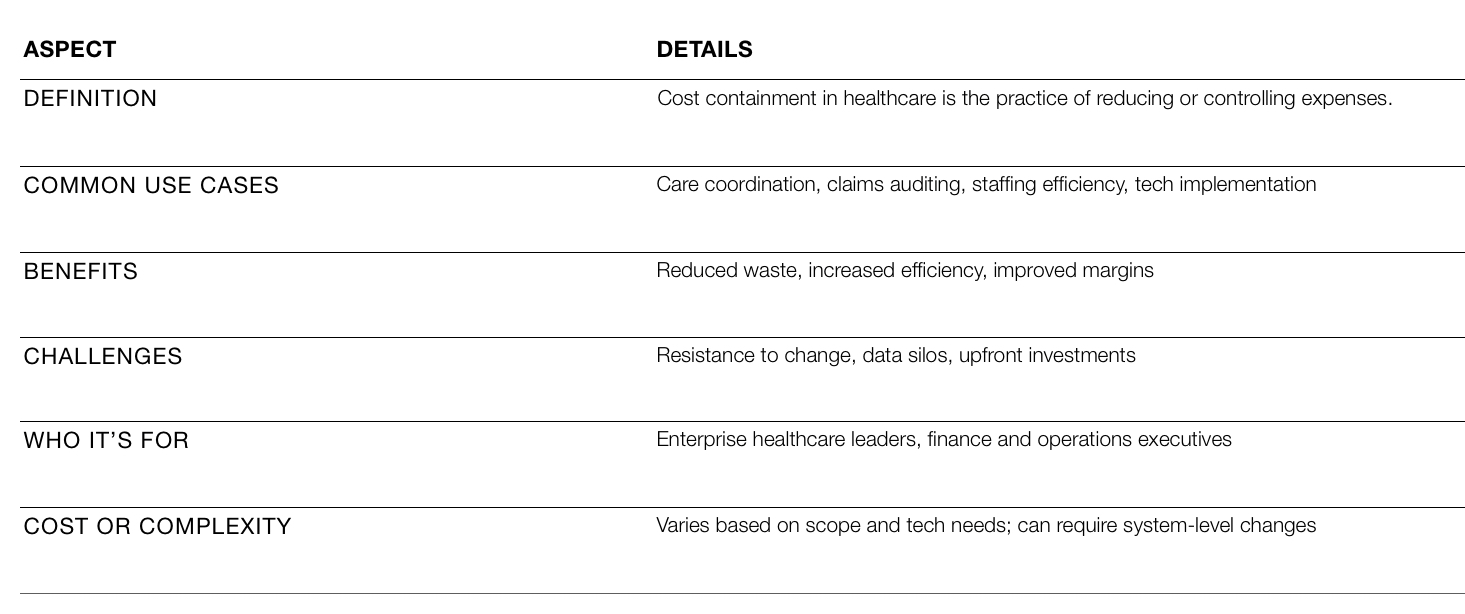
Cost Containment in Healthcare: FAQs & Key Strategies
Introduction
Healthcare leaders face constant pressure to reduce costs while maintaining quality of care. Rising operational expenses, complex reimbursement structures, and inefficiencies across clinical and administrative processes create challenges for even the most established organizations.
This article answers key questions about cost containment in healthcare, offering clear explanations and proven strategies that enterprise healthcare leaders can apply. It’s written for Directors, SVPs, VPs, and department heads at healthcare organizations with over 1,000 employees—those looking to reduce spend without sacrificing performance. You’ll leave with a better understanding of what cost containment means, why it matters, and how to implement it effectively across your organization.
Market Context: Disruption & Opportunity
Healthcare costs continue to rise. Payers and providers are under pressure to deliver better outcomes with fewer resources. Economic constraints, labor shortages, and outdated systems increase the urgency to adopt smarter approaches to spending. Many enterprise healthcare companies lack a clear framework for identifying and implementing meaningful cost reduction strategies in healthcare.
This shift creates both a challenge and an opportunity. Leaders who embrace strategic healthcare cost reduction can reinvest savings into innovation, improve patient satisfaction, and gain an edge over competitors. As payment models shift and patients demand more value, healthcare organizations must rethink how they operate and spend. Forward-thinking leaders now see cost containment strategies in healthcare not as a defensive measure, but as a pathway to long-term resilience and growth.
FAQs Snapshot

What is cost containment in healthcare?
Cost containment in healthcare refers to the strategies, processes, and actions used to reduce or control expenses without compromising quality. It involves identifying inefficiencies in operations, managing resource allocation, and using data to guide decision-making. Effective healthcare cost containment strategies aim to streamline care delivery, reduce waste, and align spending with value.
Why is cost containment important in healthcare?
Cost containment is essential because it allows healthcare organizations to remain financially sustainable while improving patient outcomes. Rising costs affect both providers and patients, and unchecked spending can limit innovation and access. By adopting cost containment strategies in healthcare, providers can allocate resources more effectively and drive long-term improvement.
What are common cost reduction strategies for healthcare organizations?
Organizations use several proven methods, including reducing unnecessary procedures, renegotiating supplier contracts, improving care coordination, and investing in automation. These cost reduction strategies for healthcare organizations help reduce operating expenses and improve financial performance without affecting the quality of care.
How does cost reduction in healthcare impact patient outcomes?
When done well, cost reduction in healthcare can improve patient outcomes by reallocating funds to areas that directly benefit patients—such as care coordination, prevention programs, and technology upgrades. However, poorly planned cuts can negatively affect care, so it’s essential to use data-driven, evidence-based methods.
Is cost containment only about cutting budgets?
No. Cost containment in healthcare is not just about reducing budgets—it’s about using resources more effectively. This includes investing in systems that prevent unnecessary readmissions, using predictive analytics to manage population health, and automating administrative tasks. The goal is to make care delivery more efficient and sustainable.
What challenges come with cost containment strategies?
Challenges include cultural resistance, lack of data visibility, and complexity in aligning stakeholders. Some cost containment strategies in healthcare require upfront investment and cross-functional collaboration, which can slow implementation. Success depends on executive buy-in and a clear roadmap.
Benefits of Cost Containment in Healthcare
Cost containment gives healthcare organizations a way to remain competitive while improving patient care. By implementing clear and focused healthcare cost reduction strategies, leaders can reduce waste, improve efficiency, and make better use of limited resources.
For example, automating manual processes cuts administrative overhead. Coordinated care models reduce unnecessary hospital visits. Standardized treatment protocols improve consistency and reduce variation in care. These cost reduction strategies in healthcare lower spend and free up capital for innovation. When implemented carefully, cost reduction for healthcare leads to long-term sustainability, stronger margins, and better service delivery.
Quick Summary Table

Let’s kickstart the conversation and design stuff people will love.

Deep-Dive Sections

What It Is & Why It Matters
Cost containment in healthcare is the process of identifying inefficiencies and reducing unnecessary spending while maintaining care standards. It is crucial because financial pressure affects the sustainability of healthcare organizations. With aging populations and rising treatment costs, the need for long-term healthcare cost reduction is growing. Cost containment enables organizations to survive and scale while maintaining service quality.
How It Works
Effective cost containment strategies in healthcare work by analyzing spend across departments and identifying areas for improvement. For example, analytics can reveal which treatments lead to avoidable readmissions. Automation reduces errors in billing and patient scheduling. These efforts are supported by strategic planning, clear goals, and stakeholder alignment. Organizations that use real-time data are better able to monitor progress and adjust in response to results.
When to Use It (and When Not To)
Cost containment is essential during periods of financial stress, market shifts, or organizational restructuring. However, it should not be used reactively or as a short-term fix. Leaders should avoid cutting high-value services or frontline resources without analysis. Use cost reduction strategies for healthcare organizations when you can measure performance and link spending to outcomes.
Tools or Platforms Involved
Tools include electronic health records (EHR) platforms, automation software, supply chain management systems, and business intelligence dashboards. AI-powered analytics also help identify trends and forecast spending. The most effective healthcare cost containment strategies are supported by platforms that improve visibility and decision-making.
Cost Considerations
While some cost reduction for healthcare initiatives require upfront investment, they often lead to long-term savings. Common costs include software implementation, change management, and training. However, these are often outweighed by reductions in manual errors, supply costs, and operational inefficiencies.
Scalability & Flexibility
One benefit of cost containment is its ability to scale across large healthcare organizations. Whether streamlining clinical workflows or optimizing back-office operations, most strategies can be rolled out in phases. Scalable cost reduction strategies in healthcare often start with pilot programs before being expanded system-wide.
Alternatives or Comparisons
Some organizations rely on revenue growth strategies instead of cost containment. While growing revenue is important, it’s often more difficult and less predictable than reducing waste. Combining revenue initiatives with healthcare cost reduction leads to better financial outcomes. Comparing platforms and services before implementation helps ensure alignment with organizational goals.
Trends
Trends include value-based care, real-time analytics, and AI-driven optimization. Many leaders now focus on healthcare cost reduction strategies that improve outcomes and reduce friction. Another growing area is predictive modeling to guide preventative care and resource allocation.
Pros and Cons
Pros: Lower operating costs, improved resource use, greater sustainability.
Cons: Implementation complexity, internal resistance, upfront investment.
How G&Co. Can Help
At G&Co., we help enterprise healthcare brands implement effective cost containment strategies. Our team provides strategic consulting to identify opportunities for healthcare cost reduction, align stakeholders, and implement solutions across departments. We’ve helped healthcare leaders reduce costs while improving patient outcomes through digital transformation, automation, and strategic planning.
We bring firsthand insight into what works—and what to avoid—based on years of experience in healthcare, finance, and operations. Talk to us to clarify your strategy and move forward with confidence.
Conclusion & Next Steps
Cost containment in healthcare is more than just an operational fix—it’s a strategic priority. With rising costs, shrinking margins, and growing demands, every healthcare leader needs a clear, data-driven approach to spending.
To explore how G&Co. can support your cost containment goals, reach out for a consultation. Whether you’re looking to reduce waste, modernize operations, or plan a long-term cost strategy, we’re here to help.






%20(1).png)






